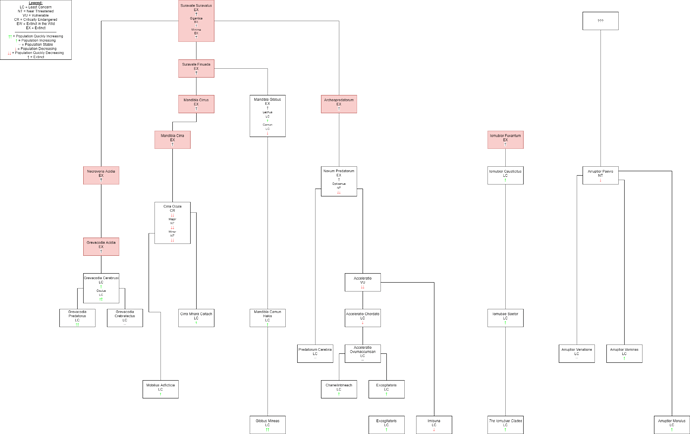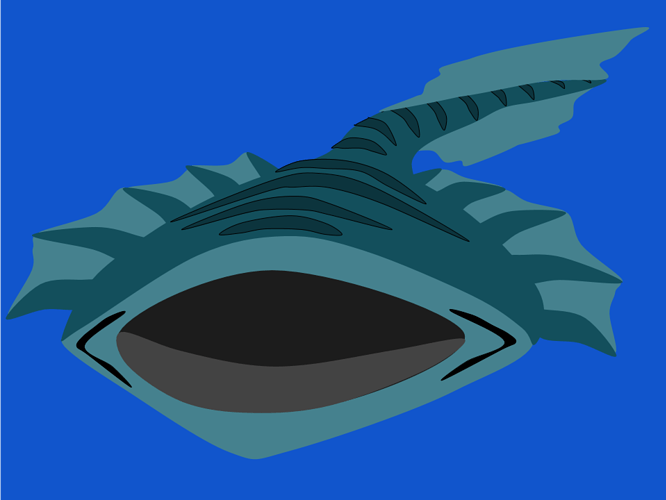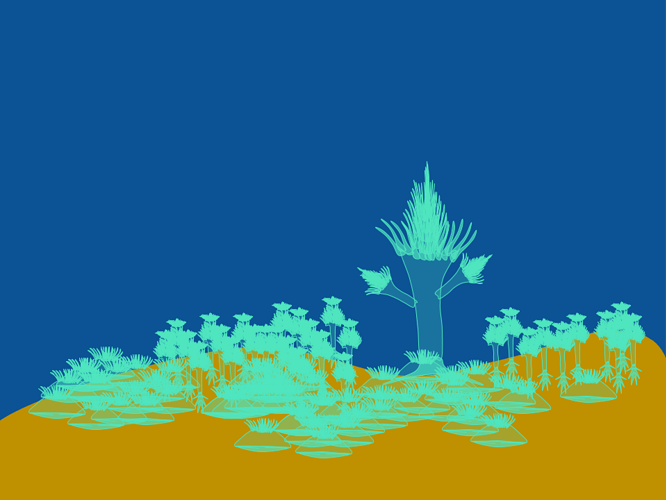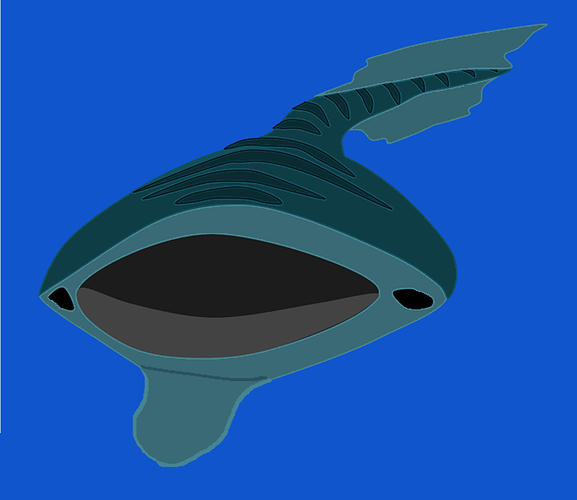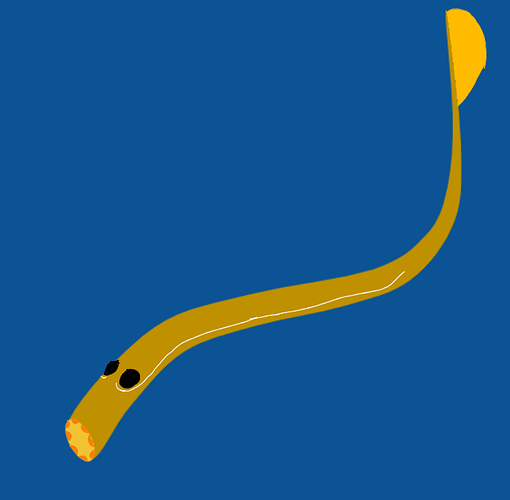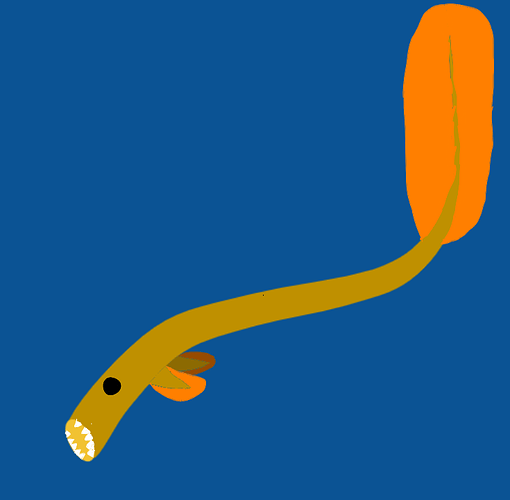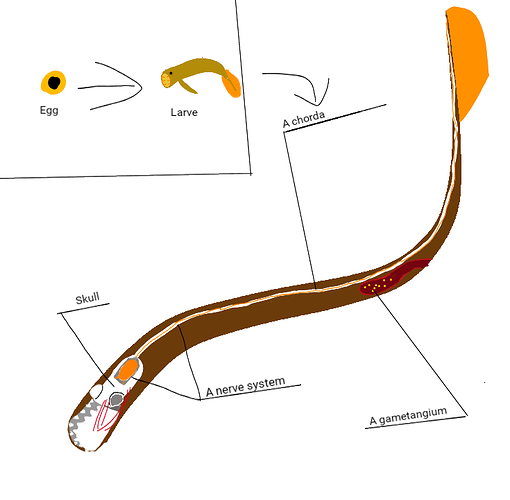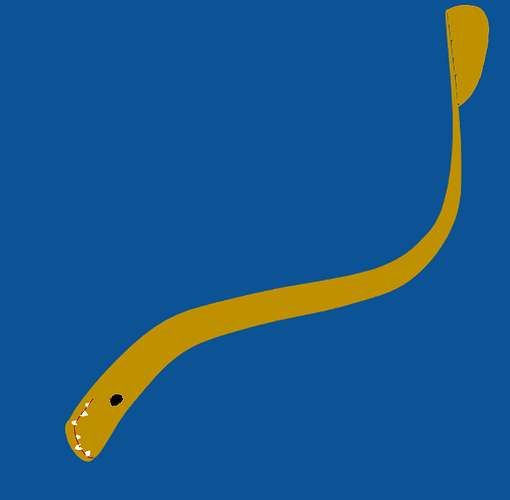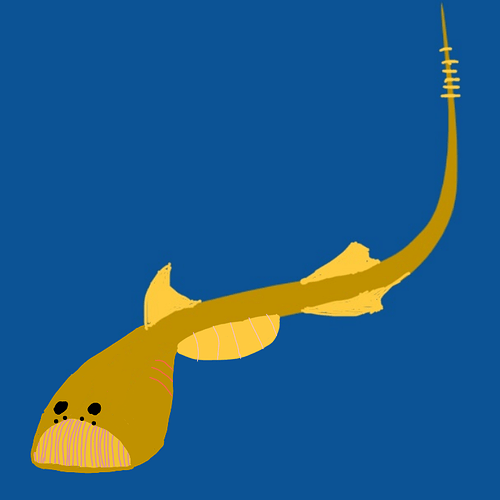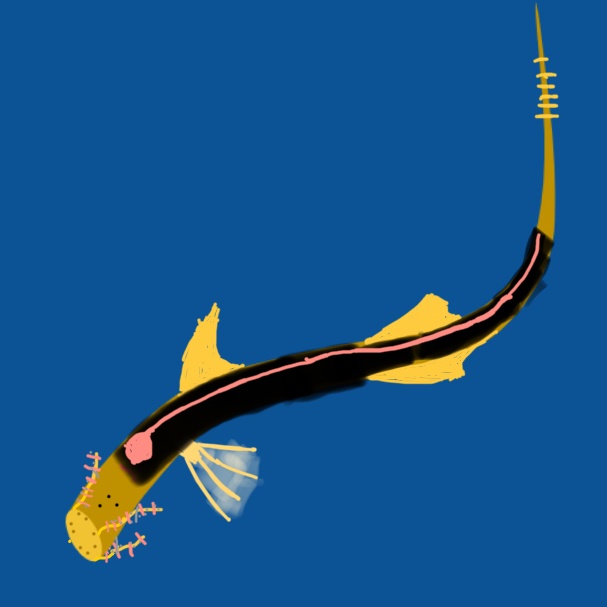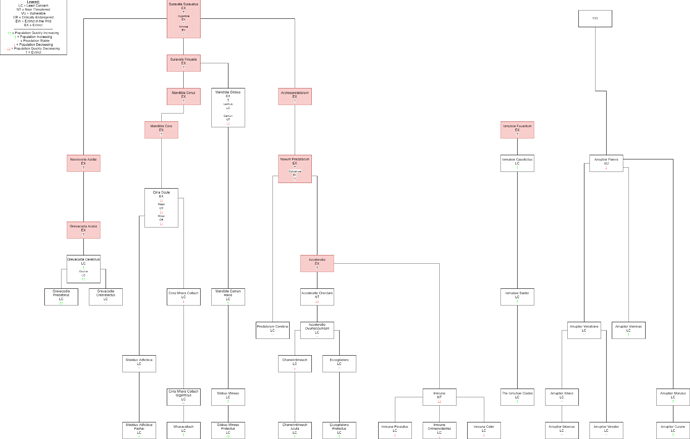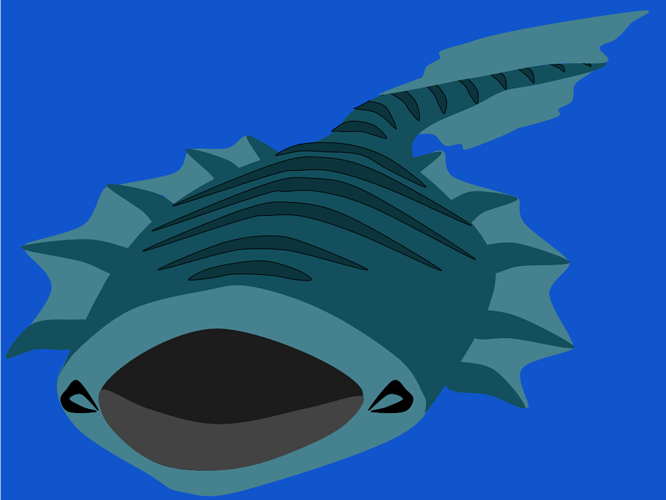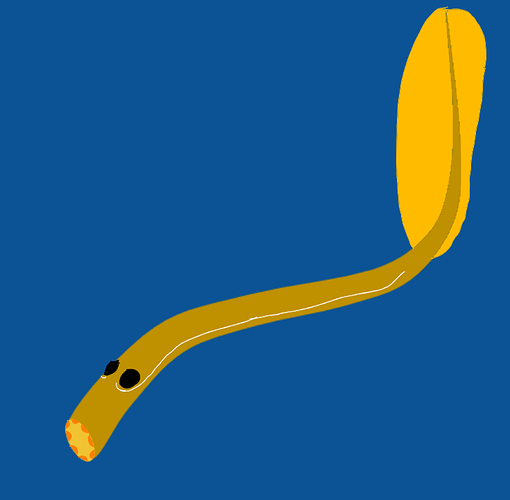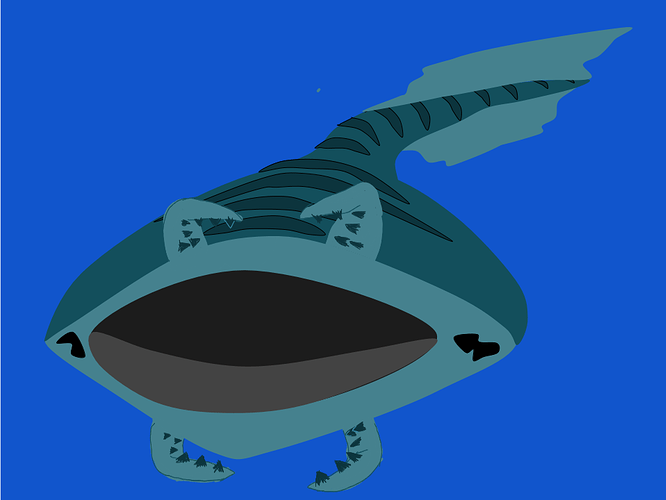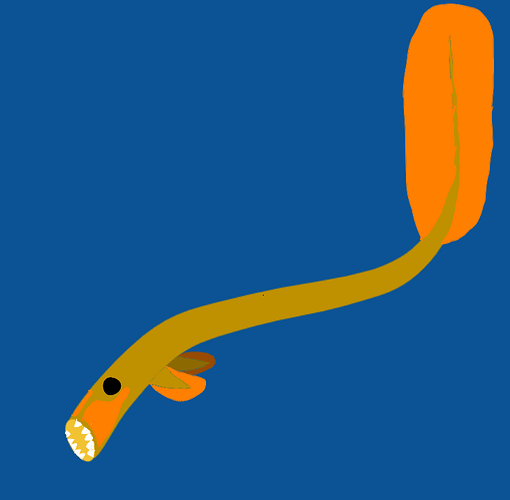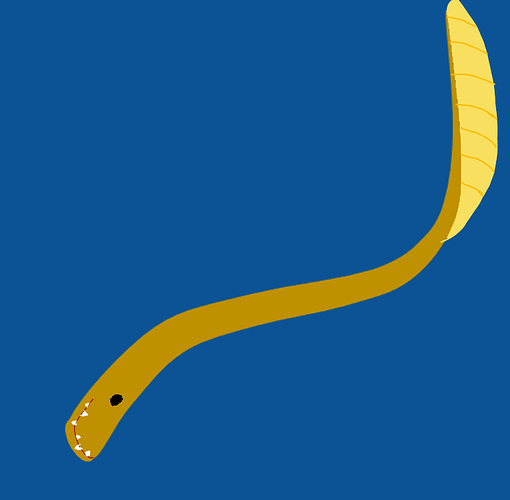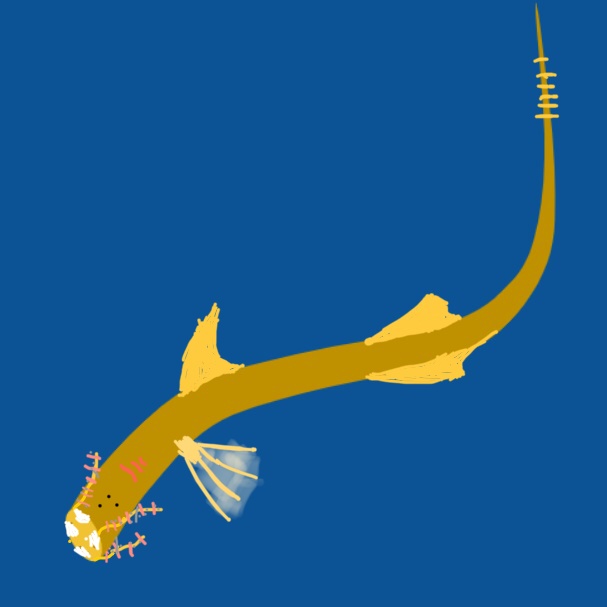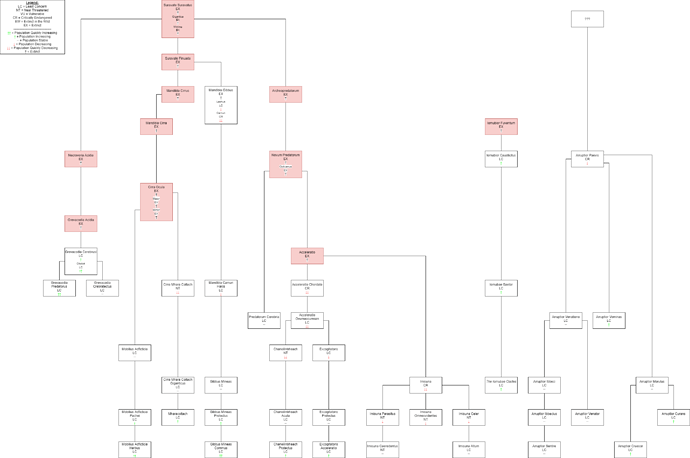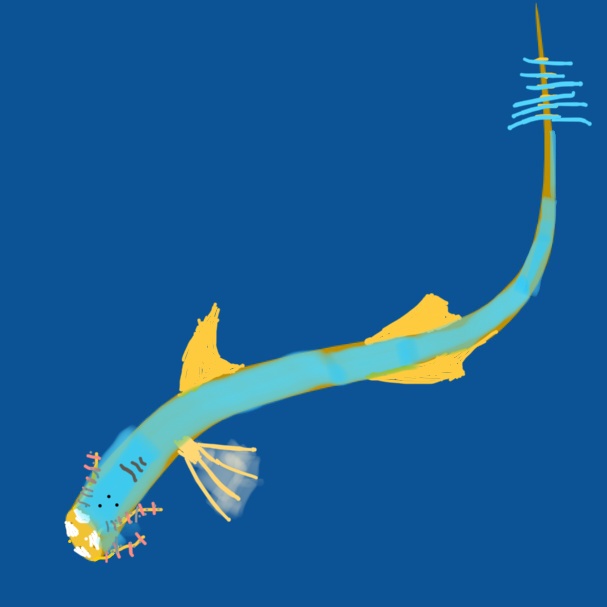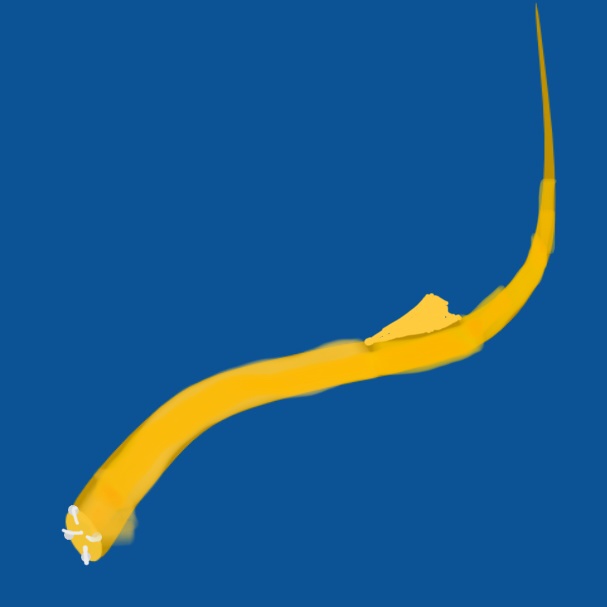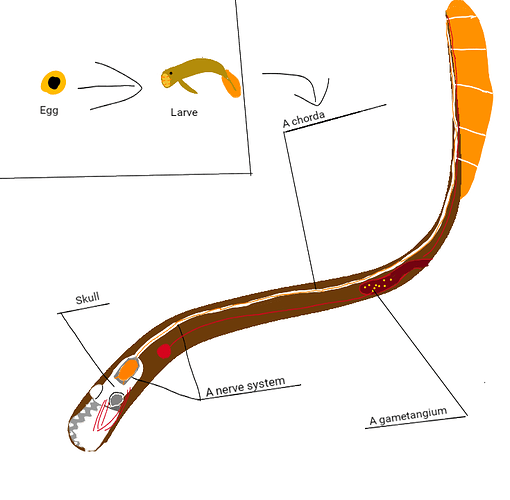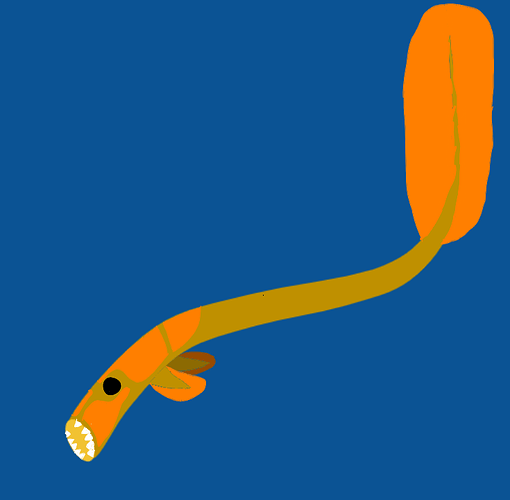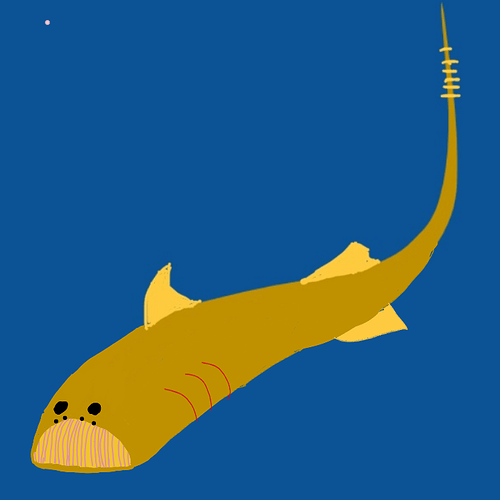Ok, I really want to join. Meet:
Old species: Arruptior Paevis
New species: Arruptior morulus (morulus - dark)
Changes: Now, they live in depth and they got darker than their ancestors,eyes open more to see better.
Behavior: Arruptior morulus hunt from ambush, waiting on underwater rocks and watching up. Before the mating period, males make a small pile of corpses. The males with bigger huddles are chosen by females. After that, females lay eggs next to that huddles. When the young appear, they firstly live next to it(and eat their yolk) and after, if it won’t be any food more, they eat that corpses. That happened because of a small number of creatures living in the deep.
I hope, here (on depth)aren’t so much decaytion bacteria.

And Friday for me will finish through 3 hours, I wait you lol.
Welcome Gotor! Many species will rise to prominence by your hand.
Arruptior Vominas has protected itself against it’s own venom. It’s hunting patterns haven’t changed, only that it doesn’t get confused when attacking Surav worms. Sometimes, it snacks on baby Paevi and Venatione. Mobilius Adfictia have developed a small cluster of nerve cells near it’s front, and it’s fins can move. Adfictia are now pack predators, although they have no sophisticated tactics, mostly because their brain is not big enough. Gibbus Mineas has become more eusocial, with a colony system forming. These colonies rest in the Open Ocean Floor biome, and they are found around Grevacod worms, who lord over 1-2 colonies at a time. Chaneilinbheach has gained a mutation, forming flaps of skin on it’s proto-flippers. It has also grown bigger. Imisuna has evolved, and they escape to the deep, where they prey on the various Iomubae clades at the Deep Sea Divots. Excogitatoris Protectus has evolved a tight-fitting skull that protects their brain and eyes. They have groups where the females hunt, and the males protect the eggs. However, these colonies disperse over time, and they only come together while mating. It is at these times that you will see the looming shadow of an Ibbeci waiting to bear down on the Excogitatoris. Cirra Mhara Coltach has grown bigger, about 1 centimeter long. Arruptiors have had two new species evolved, the Morulus, which has gone to the Open Ocean Floor, and shares (and competes) with Grevacods and their Camun charges. The Ibbeci has also evolved, a species that has evolved in an interesting way. Remember the Venatione? An Arruptior strain sprung from the Venatione, gaining mutations that caused the appendages to spring up on it’s side instead of the mouth area. It also gained a mutation where the lower has of the fin was duplicated in between the appendages. This allows it to beat it’s tail and use a rowing-like motion for it’s Ibber, which is what the new appendages have been dubbed. It has gained speed, and it hunts by itself, only coming together in clusters for mating purposes. It has been seen swimming aimlessly, and corpses have sprung up on the other side of Kakhitt. They trend towards the shallows, only coming lower if the Excogitatoris are mating. It’s eyes have also changed into a V-shape, which doesn’t seem to have any real evolutionary advantage.
Meet the Iomubae Clades! A while ago, an Iomubae Saetor had it’s motile appendage mutated so that it could not swim, and it sunk. Luckily for it, it had very good feeder-arms, and so it thrived. Many mutations later, sea plants emerged, with the tallest ones only being seen in the Deep-sea Divots, which have been renamed to the Deep-sea Havens. The smaller ones can be seen spreading across the ocean floor, from the shallows to the deep. They are all blue-green, not having lost their photosynthetic pigment yet, but that is soon to change.
Sorry for the low quality of the drawing, I just wanted to show how a few of them looked. They are diverse, so I can’t nearly draw all of them, although you are free to evolve new Iomubae! Note, however, that they must:
- Be of the Genus Iomubae
- Have some sort of feeding appendage, most likely based off the feeding appendages of the Saetor
- Not be motile (at least in adult form). If the larvae are motile, it is fine, but the adults have lost that capability forever. Of course, larval evolutions may occur.
- Have a base, represented by a flattened/differently shaped motile tool (of the Saetor).
These species will be placed in the Iomubae Clades, and won’t really evolve much over time, but if there is a big enough difference, for example, if a larva begins to swim like the Surav and the Arruptiors, I will make it a new species.
Can I ask you? Where you do that fantastic pictures? Photoshop?
Old species: Imisuna
New species: Imisuna Celer (fast)
Changes: some of Imisunas got tail fin at other side of tail and small fleshy growths like ventral fins. It helps them in faster moving.
Changes in behavior: They do many holes, sometimes even into the stone, where grows up its young.
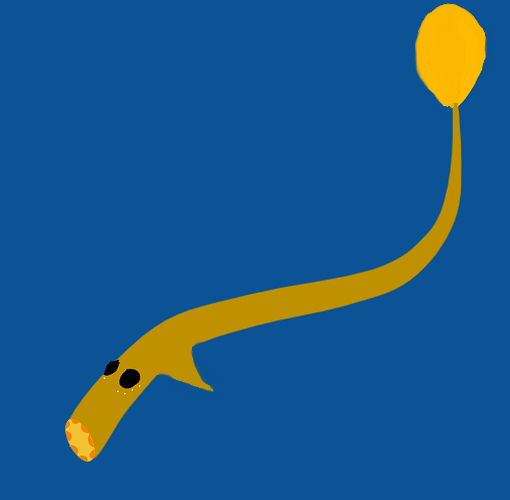
Old species: Imisuna
New species: Imisuna parasitus
Changes: Thanks for crushing “teeth”, Imisunas start clinging for Arruptors (usually for morulus) and drink their “blood” with getting their nutrients, like leeches or mixins.
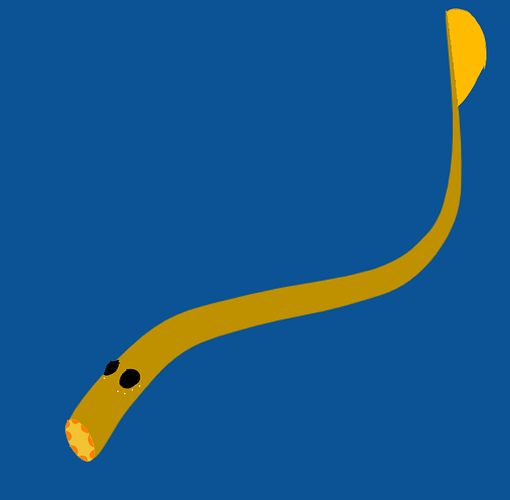
Old species: Arruptor morulus
New species: Arruptor curans (caring)
Changes: on lower “jaw” appeared cartilaginous outgrowth, like a shovel. It appeared in order to be convenient to carry offspring (ONLY for MALES). The top iscodial plate increase number of neurons.
Changes in behavior: Now, males guard the eggs, and after hatching of young, carries them on his "shovel’ until it grows. And more, females choose males with bigger “shovels”.
I hope, that’s all, that i wanted to do.
Nice evos there @Gotor
New species: imisuna omnesvidentes
Old species: imisuna
Changes: the vibration sensors have evolved all over the body but not the tail
New species: chaneilinbheach acuta
Old species: chaneilinbheach
Changes: chaneilinbheach has evolved mineralised teeths
New species: excogitatoris protectus
Old species: excogitatoris protectus
Changes: protectus has evolved two jaws with very sharp teeth offensive “defense” against the Ibbeci
And also they have gain some size up to 1cm as a another defense
New species: venator
Old species: arruptior venatione
Behavior changes: venator despite looking littelary like its predesesor has started to eat and hunt other arruptior species.
New species: mharacoltach
Old species: circa mhara coltach giganticus
Changes: mharacoltach has evolved into even bigger size up to 5cm and also has evolved a set if stabilising fins on its side
New species: Mobilius Adfictia Pachei
Old Species: Mobilius Adfictia
Changes: Pachei has evolved a larger brain and spinal cord.
Behavior: Pachei hunts in packs. They hide in plants, slowly munching while they wait for their prey. When it arrives, all but one start to chase the prey. They eventually chase the prey back to the starting point where the last one is to waiting to strike. They live in mostly the sea plant groves.
New species: Gibbus Mineas protectus
Old species: Gibbus Mineas
Changes: protect us has evolved a hard, mineral shell on the top of its back. This protects it from most predators. The queen has a faster reproductive rate, and has white strips on the top of its back. The queen is about 0.2 cm bigger.
Behavior: They now build small mounds out of rock and sand which they burrow into for the queen and during attacks.
Worker:
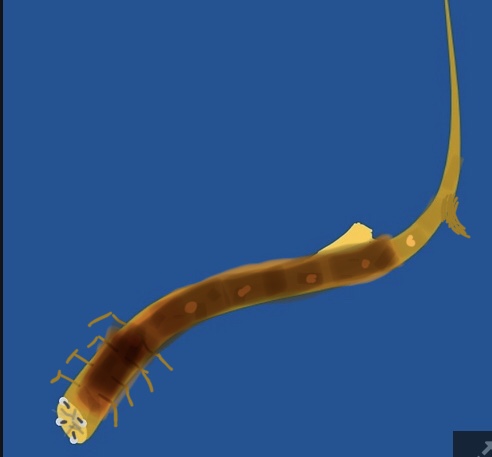
Queen:
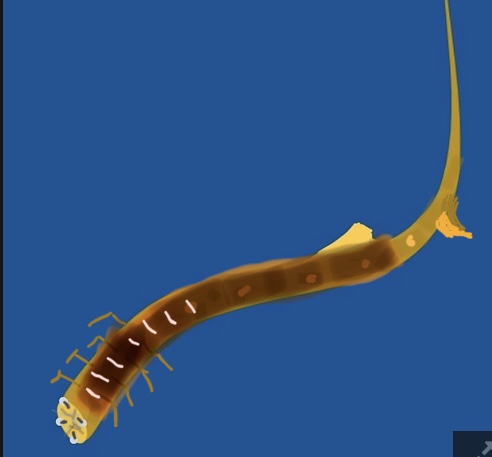
Hey Oofer, I noticed that your Bahhus have become “herders”. At this level of intelligence, it isn’t really possible to raise livestock like they are doing, and so you’ll need to change that. Also, just to clarify, the Mineas Protectus have brains (or any similar thing, e.x; Iscodial Plates), correct? Otherwise they will need to have some pheromone-based thing in order to make this colony.
Also, Gotor, I use Sketchpad 5.1 and Google Draw. They’re both useful, but for different things.
Thank you for answers
the mineas protectus do have tiny brains.
Unfortunately, no updates today. Got a test tmw and on tuesday, so I had to study. However, I am making something new for this as well! A new event, perhaps 
Species evolved, you know the drill. The Imisuna are being heavily targeted by the new predators on the scene. The Excogitatoris is growing stronger, and currently, the biggest Surav worm is the Mharacoltach, an amalgamation of the previous name, at 5 cm. The Arruptiors have grown lesser in number, and the Surav worms thrive, even as they die. It is stable in the environment.
There have been many skirmishes between the Surav and the Arruptiors, but today, a fight was finally one by one of the Surav. One point for them, against the many thousands for the Arruptiors. A Grevacod-worm was grappling with a Juvenile Arruptior, finally pinning it to the seabed. Some Mineas Protectus began to bite at it, believing it was a corpse. The Arruptior died a grisly death, and that singular Grevacod-worm was able to learn how to kill juv-Arruptiors.
Meet Arruptior Ibbecius, an interesting new variety of the Arruptior genus. For one, it has become longer, and more sleek. The eyes have come back together into more circular shapes, and the behavior has drastically changed. Ibbecius now carries a few young on it’s back (Ibbecius have a very low spawn rate, their eggs being preyed on by Surav worms) while it hunts, teaching them techniques. If they grow up, and possibly do something different than their parents, their young learn that different technique. However, the Arruptior is a long way away from sentience, only just barely being aware of it’s surroundings and itself. There is a long way to go. The Ibbecius have begun moving to the shallows, and, in an interesting turn of events, so have some stray colonies of Mineas Protectus, Grevacods following behind.
Old species: Imisuna Celer
New species: Imisuna Altum
Changes: On spine appeared a fin along the body and paired fins were extended. Now, some of the Imisuna Altum can run away from Arruptors in deep sea.
Changes in behavior: Now, they do holes in some one place and males defend eggs all time before hatching with simple being near them.
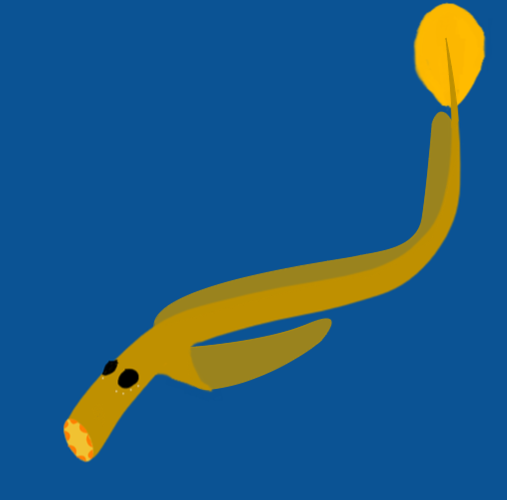
Old species: Imisuna parasitus
New species: Imisuna Bluetooth
Changes: because of disuse, organs of sensation vibrations (white points around eyes), they degradate, disappear. Their tooth are merged in 3 big tooth, that with time stay blue because of oxide of cuprum, dockable to them.
Changes in behavior: eggs are layed under small stones. When young is appear, it swim to nearest animal and attaches for full life, with detaching only for pairing.
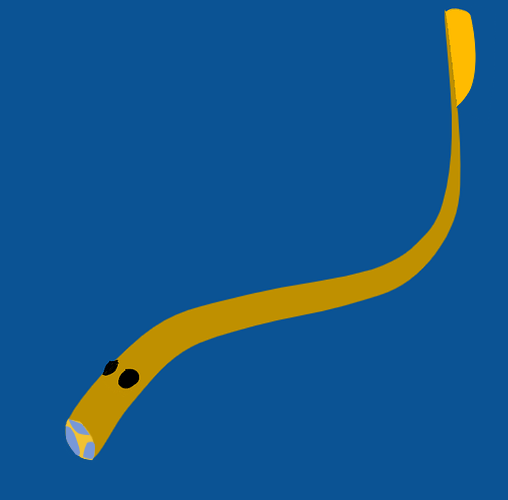
Old species: Arruptor morulus
New species: Arruptor cruise
Changes: They smaller ( around 0,7-1m) and got paired fins (0,2m). Races with Imisuna Altum are opened!
Changes in behavior: nothing new.
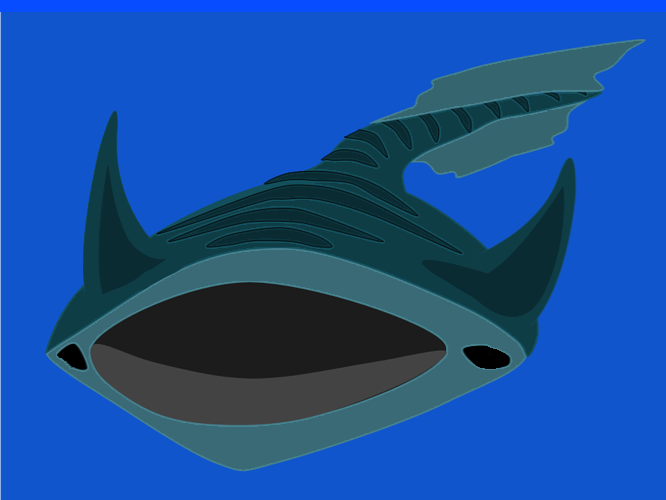
Old species: Arruptor Ibbecius
New species: Arruptor Sentire
Changes: Eyes got elliptical shape and, in mouth, appeared 2 little holes, arranged in series. On their walls, there are olfactory receptors.
Changes in behavior: In the hungry times, they eat eggs.

That so hard…
New species: imisuna omnesvidentes
Old species: imisuna omnesvidentes
Changes: imisuna has evolved longer tailfin
New species: arruptior venator
Old species: arruptior venator
Changes: venator has evolved hardened sharp “teeth” that is more usefull to tear down its prey
New species: chaneilinbheach protectus
Old species: chaneilinbheach acuta
Changes: protectus has evolved hard skin on top of their head
New species: excogitatoris accelerato
Old species: excogitatoris protectus
Changes: excogitatoris has evolved a longer tailfin and also has evolved into a bigger size (1cm)
New species: Mobilius Adfictia Pachei
Old Species: Mobilius Adfictia Pachei
Changes: Pachei has evolved a basic heart that helps it keep up its chase longer. They also have grown slightly, now they are 1-2 cm
Behavior: Another hunting technique is to chase their prey for long periods of time until it is to tired to continue moving. Similar to wild dogs.
New species: Mobilius Adfictia Herbus
Old species: Mobilius Adfictia Pachei
Changes: Herbus has evolved large crushing teeth for eating plants. They have become less energetic but have grown to 1.3-2.4 cm.
Behavior: they live mostly in rivers, but also anywhere else with large plant cover.
New species: Gibbus Mineas Commus
Old species: Gibbus Mineas Protectus
Changes: Commus has evolved large differentiation between workers and the queen. The queen has evolved an extremely bulbous back, which holds the egg production system. The workers have lost their reproductive system, and are now darker and more rough. Their teeth have become sharper and hooked.
Behavior: They all serve the queen.
Worker:
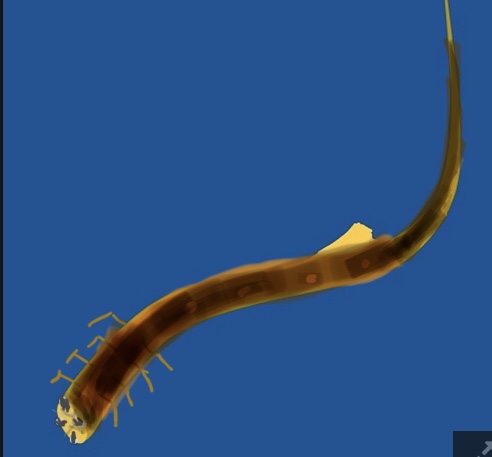
Queen:
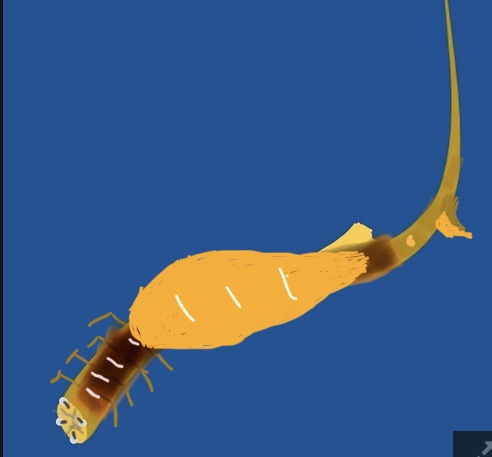
Sorry for the horrid pictures.
You know the drill. Species evolved, species went extinct. What’s interesting is the evolution of the Commus, the Ibbecius that didn’t migrate to the shallows (they became the Sentire) and the races they have with the faster Surav worms. However, one of the most interesting evolutions is Herbus, not because of the fact that they gained teeth, but the fact that they went into rivers. However, the Ibbecius are following them there, their bodies growing slimmer so as to weave through the rivers and streams. The nutrients on Kakhitt are dying down, and there is a scramble. Luckily, the organisms are already pretty well adapted to the environment. Meanwhile, the plants in the Seaplant groves are growing closer and closer to shore.
Very short today, but great work! After we break 75 posts, I am going to make a discord, so if you don’t have an account, you should probably make one for efficiency. I’ll post the updates here, though.
75 your posts or in general?
Old species: Imisuna Bluetooth
New species:Imisuna Simplex
Changes: around the mouth appeared skin ring with suckers (usually 8, but there are many beings with 9, 10, and even 14), skin grows over the eyes, tail fin is reduced, disappeared. Decrease to 0,25-0,5mm.
Behavior: they are endoparasites, live in the esophagus. Maybe i’ll do some more information, now i don’t know, what write here.
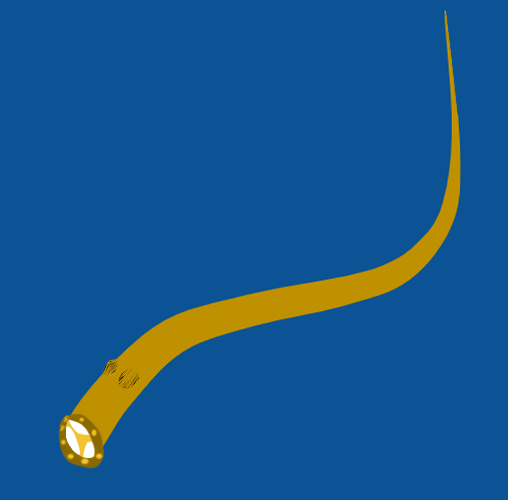
Old species: Imisuna Celer
New species: Imisuna piscis
Changes: It has proto jaws with many small teeth to eat faster and more algae. Back and tail fins coalesced.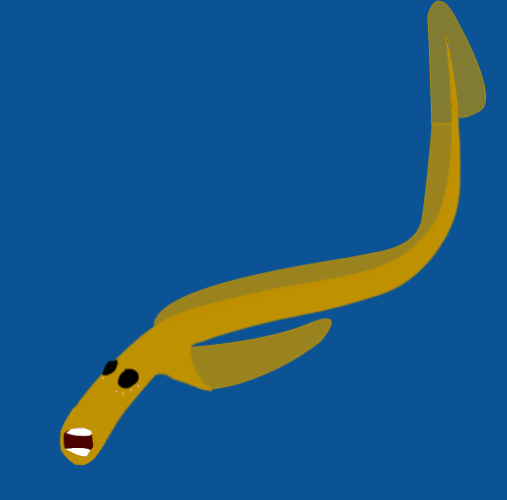
New species: Mobilius Adfictia Pachei
Old Species: Mobilius Adfictia Pachei
Changes:Pachei has grown slightly, now they are 2.5-3.8 cm. No visual changes
Behavior: In larger groups of ten, they start to attack Arruptiors, attacking from the back and running away before the Arruptiors can grab at them.
New species: Mobilius Adfictia Herbus
Old species: Mobilius Adfictia Herbus
Changes: Herbus has become the color of the plants(it’s blue right?) and the protrusions on the end of its tail look like feeder tubes of an Iomubae.
Behavior: When predators come near, it tries to look like plants.
New species: Gibbus Mineas Commus
Old species: Gibbus Mineas Commus
Changes: The queen is more bloated. Worker’s shells are now slightly stronger. No visual changes.
Behavior: Queen never leaves the mound, small group of workers attend and also don’t leave the mound.
New Species: Lechus
Old Species: Mandibla Gibbus Lechus
Changes: the Lechus’s teeth have become straw like and the outside of the Lechus has a mineral shell.
I look at your creatures and feel myself a little slow in evolves)
New species: excogitatoris accelerato
Old species: excogitatoris accelerato
Changes: excogitatoris has evolved a primitive heart and circularry system
New species: chaneilinbheach protectus
Old species: chaneilinbheach protectus
Changes: protectus has evolved more hard skin around his head
New species: mharacoltach meltingu
Old species: mharacoltach
Changes: mharacoltach has evolved an advanced digestive system so it can get as many energy from what it eats.
Old species: Iomubae ???
New species: Iomubae ruber
Changes: chloroplasts( or phycocyanin) were replaced with phycoerythrin (red analogue of firsts) and, thanks to that, they can live in deep sea, where before wasn’t any life.
Description: Iomubae ruber - red algae. It has rhizoids, flattened thallus below, above the thallus is almost transparent, has a lot of sprouts. That sprouts will tear and, after many hours, they will be at ground and grow their first rhizoids. To stay alive after many hours of simple swimming in deep sea, they have so much nutrients even on the mother plant.
P.S. I know, that red and green algae - different classes (if not more), and, if you don’t want to add them, i’ll not take offence so much, but i worked with it so much time.
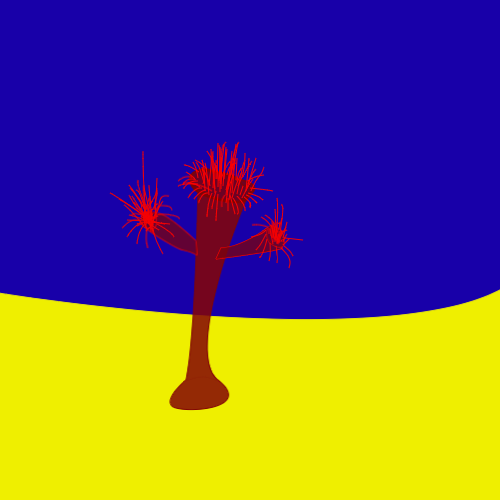
Really thank you for sketchpad 
No update today, however I am setting up the discord server! Also, Gotor, to answer your question, it is after 75 posts in general. Also, it’s Iomubae (as in iomubae), not Lomubae lol, my apologies  red algae is certainly permissible, as the Iomubae clades living in the deepsea don’t really use any of their photoproteins, and they will soon lose color completely, except perhaps to attract or repel animals. Besides, Phycocyanin and Phycoerythrin are very structurally similar (atleast in my eyes lol) so I don’t doubt that a mutation in the Phycocyanin gene could create phycoerythrin, or something close enough to it.
red algae is certainly permissible, as the Iomubae clades living in the deepsea don’t really use any of their photoproteins, and they will soon lose color completely, except perhaps to attract or repel animals. Besides, Phycocyanin and Phycoerythrin are very structurally similar (atleast in my eyes lol) so I don’t doubt that a mutation in the Phycocyanin gene could create phycoerythrin, or something close enough to it.
